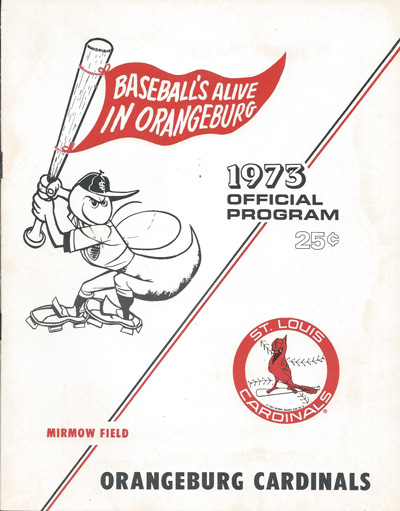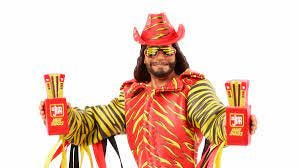Quick Link
Elvis Perkins to Slim Jims, by way of Stephen Sondheim, conversion therapy, and the Western Carolinas League of 1973
The first professional baseball game I ever attended was at Mirmow Field, Orangeburg, SC, in 1973. There was a lot of buzz around town—it wasn’t a town with many competing buzzes—about the new minor-league team, the Orangeburg Cardinals of the Western Carolinas League. Even at seven, I understood that the manager was an ex-big-leaguer and celebrity: Jimmy Piersall, two-time American League all-star. I knew, too, that Piersall was known for his unpredictable antics: cleaning home plate with a water gun, communing with the ghost of Babe Ruth behind the outfield wall at Yankee Stadium, running the bases in the correct order but backward after his hundredth major-league home run, going into the batter’s box in a Little League helmet, and so on. What I didn’t know was the darkness behind the “comic” eccentricities. Pearsall at twenty-two, pissing off Red Sox teammates by cockily nicknaming himself “The Waterbury Wizard” and trying to make the moniker stick; the many fistfights and out-of-the-blue blow-ups that followed, including an incident in which Pearsall spanked a teammate’s four-year-old in the clubhouse during a game; the many, many ejections, including one for sprinting back and forth across the outfield during an at-bat by Ted Williams; eventually the diagnosis of severe bipolar disorder and several stints in psychiatric hospitals, where he underwent electroshock and became one of the first people to be prescribed lithium. I didn’t know yet to associate him with Fear Strikes Out, the 1955 autobiography that led to the 1957 film starring Anthony Perkins as perhaps the least realistic-seeming major leaguer in cinematic history. 1
It turned out that Pearsall had been hired pretty much straight out of another hospitalization, and his four months in Orangeburg would be the only managerial stint of his career. (In 1974 he would join the Texas Rangers as a TV analyst.)
Pearsall’s best player was Tito Landrum, who would go on to a major-league career in which he would hit .385 in the 1985 postseason that resulted in a Cardinals’ World Series crown. But the player who was to be most FAMOUS was a twenty-year-old outfielder and designated hitter named Randy Poffo, who in 46 games with Orangeburg hit .250 with 2 home runs. Poffo at some point sustained a major injury to his throwing shoulder. Unable to give up his baseball dreams, he taught himself to throw left-handed (though it’s not clear he ever used this newfound skill in a game). He would last one more season, in the Cincinnati Reds’ farm system, where a .232 average over 500-plus plate appearances put an end to his baseball career.
But during the 1973 off-season, encouraged by his old man to take up the elder Poffo’s trade, the young man had already taken the first step toward his new career. His next move was prophesied in a way on his 1974 baseball card, which reported that as part of injury rehab he had taken up serious weight training. When life hurls you into the turnbuckle and stomps on your face, what to do? Soon the younger Poffo would oil himself up, hit the spray tan hard, and soon enough he’d be stepping into a Slim Jim as perhaps the most beloved wrestler of the late 1980s and early 1990s, Randy “Macho Man” Savage.
“Oh, yeaaaah.”
Five Perkins facts in a hurry: 1) father of the great Elvis Perkins, the artist my daughter and I most want to see play live but know we never will—unless it somehow becomes possible to travel the concert circuit with a theremin player, two trombonists, a trumpeter, etc. 2) One of the more or less openly gay but closeted-by-the-studios film stars of the 1950s, he had a years-long affair with Tab Hunter . . . who, in a weird coincidence, played Piersall in the 1955 TV version of Fear Strikes Out. 3) Is said to have had his first heterosexual experience at age 39, on set of The Life and Times of Judge Roy Bean, with Victoria Principal. The studio heads thought Perkins flaunted his gayness too much and had been trying for years to get him to commit to trying conversion therapy; during this stretch he met model and photographer Berry Berenson (sister of Marisa), and when she became pregnant in 1973, they got married. (Film director Oz Perkins was born in 1974; Elvis would come along two years later.) 4) In 1992 Perkins would die of AIDS, which diagnosis remained concealed from the public until near the end. (Berenson would die on September 11, 2001, in one of the planes that hit the World Trade Center. “Now in all my wildest dreams, it never once was seen/ That Doomsday would fall anywhere near a Tuesday,” as Elvis P. put it in his song “Doomsday.”) 5) Perkins was a frequent collaborator with his pal Stephen Sondheim on all kinds of musical mysteries and shows and puzzles. The most successful of these, a genuinely bizarre film whodunit called The Last of Sheila (1973), is a murder mystery that grew out of the tricksome scavenger hunts Perkins and Sondheim devised for their NYC friends.




Hello Michael...enjoyed this "only in S.C." piece very much, especially this line: "it wasn’t a town with many competing buzzes".....please holler if you're headed to S.C. We're still in Georgetown....
It'll stay free! And great to hear from you! Still in Durham?